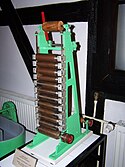Kalandrování textilií
Kalandrování je zušlechťovací proces, při kterém se na plošné textilie působí tlakem otáčejících se válců.
Účelem kalandrování je dodat textilnímu materiálu určitý vzhled nebo omak.
Kalandrovací stroje
Stroje sestávají nejčastěji ze 3-7 válců nad sebou, vždy střídavě jeden kovový (s možností vyhřívání) a jeden s elastickým či bavlněným povrchem. Přítlak mezi válci může dosáhnout až 1200 kN, rychlost do 200 m/min.[1]
K nejpoužívanějším kalandrům patří:
- Válcový - univerzální zařízení na matování nebo leštění textilií
- Frikční – zboží se hladí za současného tření (chintzový efekt)
- Rýhovaný – ohřívané ocelové válce s jemným rýhováním (např. na hedvábné tkaniny)
- Gaufrovací – k ražení různých vzorů nebo také ke zpevňování rouna u netkaných textilií
- Chaisingový – zboží prochází ložené v několika vrstvách nad sebou, tím se dosáhne matného lesku (proces je podobný mandlování)
- Simili Kalandr – vlhké zboží prochází kalandrem při vysoké teplotě a tlaku. Tím se dosáhne na bavlněných nebo viskózových tkaninách lesku, který se však po vyprání ztrácí
- Plsticí – k sušení a úpravě vlněných tkanin
- Termo Kalandr – zpevnění netkaných textilií mezi ohřívanými válci (termobonding)
- Pletařský – zařízení na paření pletenin hadicového tvaru
Efekty získané kalandrováním
Žlábky, hedvábný povrch textilie, gaufrový efekt (krep), moaré, chintz a další mohou být:
- stálé při praní – vzniklé termofixací textilií z plastických vláken
- nestálé při praní - efekty získané kalandrováním na textiliích z celulózových vláken (např. bavlna, viskóza). Zvýšení stálosti se zde dosáhne síťovacími přípravky, které se přidávají před kalandrováním a po průchodu kalandrem se provádí vlastní zesítění.
- Schéma kalandrování
- Model kalandru
- (c) I, Alexei Kouprianov, CC BY 2.5Muzeální kalandr (Finsko)
- Pětiválcový kalandr z roku 1907 (USA)
Literatura
- Pospíšil a kol.: Příručka textilního odborníka, SNTL Praha 1981
Externí odkazy
 Obrázky, zvuky či videa k tématu kalandrování textilií na Wikimedia Commons
Obrázky, zvuky či videa k tématu kalandrování textilií na Wikimedia Commons
Reference
- ↑ Příklad kalandrovacího stroje: http://www.menzel-maschinenbau.de/Glaettkalander-M225-05.434.0.html Archivováno 9. 11. 2009 na Wayback Machine.
Média použitá na této stránce
Autor: Internet Archive Book Images, Licence: No restrictions
Identifier: cyclopediaoftext06chic (find matches)
Title: Cyclopedia of textile work : a general reference library on cotton, woollen and worsted yarn manufacture, weaving, designing, chemistry and dyeing, finishing, knitting, and allied subjects
Year: 1907 (1900s)
Authors:
Subjects: Textile industry Textile fabrics
Publisher: Chicago : American school of correspondence
Contributing Library: Claire T. Carney Library, University of Massachusetts Dartmouth
Digitizing Sponsor: Claire T. Carney Library, University of Massachusetts Dartmouth
View Book Page: Book Viewer
About This Book: Catalog Entry
View All Images: All Images From Book
Click here to view book online to see this illustration in context in a browseable online version of this book.
Text Appearing Before Image:
Fio-. 13. 75. Raw Silk. Ti:e next ste() in the process of silk mikingis called reeling. The cocoons are sorted into grades of differentquality. Tiir best cocoons are selected for the pre()aration ofwarp thread, commonly called organzine, as that has to be strong,lustrous and tightly twisted. The poorer cocoons are commonlyworked up for wc^ft or lilliug, which contains f(^wcr individualfibres, less twist than the organzine and is commonly known astram. 42
Text Appearing After Image:
FIVE-ROLL CALENDER FOR COTTON AND LINEN GOODSTextile Fiiiisliinj; Machinery Co. TEXTILE CHEMISTRY AND DYEING. 35 111 the reeling- operation a number of cocoons are placed in abasin of warm, soapy water, and a skilled operative is al)le by tlieaid of a little brush or l)room, often made of briar twigs, to catchthe outer end of tlie fibre. When this lias been done with theproper number, which may vary from three to as many as twenty,the ends are placed together, passed through a smooth guide, some-times made of agate, and then twisted seveial times about athread of similar structure to give it twist and make it smooth.This twisted thread then passes through another guide and on toa large reel. The acGom()anying cuts (Fig. lo) will give an ideaof the process. Silk reeleddirectly from thecocoon is of themost V a 1 u a 1)1 equality, and con-stitutes the raw ornet silk of com-merce. The tangledand fine loose endsof the cocoon, aswell as that ol)-tained by degum-ining the brokenand injured c
Note About Images
Autor: Lestat (Jan Mehlich), Licence: CC BY-SA 2.5
Calender for smoothing paper - model.
(c) I, Alexei Kouprianov, CC BY 2.5
Calender at the historical Verla groundwood and board mill (Finland)
Calender_process. Visualization of the calender process. April 2007. Laurens van Lieshout.







